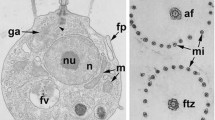Summary
The structure and behavior of the non-flagellate and flagellate phases of the slime moldEchinostelium minutum de Bary are here described from living cultures examined with phasecontrast microscopy. The ultrastructure of the myxamoebal and swarm cell phases was studied in sectioned material fixed sequentially with glutaraldehyde-acrolein and OsO4.
The nearly spherical myxamoeba has two pairs of juxtanuclear centrioles with associated microtubular arrays. During the amoebo-flagellate transformation each pair of centrioles assumes an anterior position in the cell and becomes arranged at right angles to one another within a cone of microtubules. This microtubular cytoskeleton extending under the plasmalemma establishes the twisted, narrowly ovoid form of the swarm cell. Each centriole functions potentially as a basal body. When transformed in phosphate buffer pH 6.8 at 12 °C and a cell concentration of 5×105/ml, the myxamoebae develop 1 to 8 flagella. The average number of flagella per swarm cell is 2.7. After approximately 2 hours the swarm cells begin to revert to myxamoebae by resorption of their flagella. The phylogenetic implications of these light and ultrastructural observations are discussed with regard to possible evolutionary relationships between theProtostelia andMyxomycetes.
Similar content being viewed by others
References
Aldrich, H. C., 1968: The development of flagella in swarm cells of the myxomycetePhysarum flavicomum. J. gen. Microbiol.50, 217–222.
Alexopoulos, C. J., 1960: Morphology and laboratory cultivation ofEchinostelium minutum de Bary. Amer. J. Bot.47, 37–43.
Bary, A. de, 1859: Die Mycetozoen. Ein Beitrag zur Kenntnis der niedersten Thiere. Z. Wiss. Zool.10, 88–175.
Elliot, E. W., 1948: The swarm cells of Myxomycetes. Wash. Acad. Sci. Jour.38, 133–137.
—, 1949: The swarm-cells of Myxomycetes. Mycologia41, 141–170.
Fulton, C., 1970: Amebo-flagellates as research partners: the laboratory biology ofNaegleria andTetramitus. In: Methods in cell physiology (Prescott, D. M., ed.), Vol. 4, pp. 341–476. New York and London: Academic Press.
Furtado, J. S., andL. S. Olive, 1970: Ultrastructural studies of protostelids: the amoebo-flagellate stage. Cytobiologie2, 200–219.
Gilbert, F. A., 1927: On the occurrence of biflagellate swarm cells in certain Myxomycetes. Mycologia19, 277–283.
Haskins, E. F., 1965: The developmental biology of the eumycetozoanEchinostelium minutum. Ph. D. Dissertation. University of Minnesota, Minneapolis, 105 p.
—, 1968: Developmental studies on the true slime moldEchinostelium minutum. Canad. J. Microbiol.14, 1309–1315.
—, 1970: Axenic culture of myxamoebae of the myxomyceteEchinostelium minutum Canad. J. Bot.48, 663–664.
—, 1971: Sporophore formation in the myxomyceteEchinostelium minutum de Bary. Arch. Protistenk.113, 123–130.
- 1973 a:Echinostelium minutum (Myxomycetes). Amoebal phase. Film E1816 des Inst. Wiss. Film, Göttingen.
- 1973 b:Echinostelium minutum (Myxomycetes). Plasmodial phase (Protoplasmodium). Film E1817 des Inst. Wiss. Film. Göttingen.
—, 1976: High voltage electron microscopical analysis of chromosomal number in the slime moldEchinostelium minutum de Bary. Chromosoma56, 95–100.
—, andA. A. Hinchee, 1974 a: Ultrastructure of the spore wall in the white-sporedEchinostelium minutum (Myxomycetes). Arch. Protistenk.116, 76–79.
— —1974 b: Light- and ultra-microscopical observations on the surface structure of the protoplasmodium, aphanoplasmodium, and phaneroplasmodium (Myxomycetes). Canad. J. Bot.52, 1835–1839.
— —, andR. A. Cloney, 1971: The occurrence of synaptonemal complexes in the slime moldEchinostelium minutum de Bary. J. Cell Biol.51, 898–903.
- and C. D.Therrien, 1978: The nuclear cycle of the myxomyceteEchinostelium minutum. I. Cytophotometric analysis of the nuclear DNA content of the amoebal and plasmodial phases. Exp. Mycol. In press.
Heunert, H. H., 1973: Microtechnique for the observation of living microorganisms. Zeiss Inform.81, 40–49.
Hinchee, A. A., 1976: Light and ultrastructural study of the myxomycete,Echinostelium minutum: with special emphasis on nuclear division. Ph. D. Dissertation, University of Washington, Seattle, 219 p.
Hung, C.-Y., andL. S. Olive, 1972: Ultrastructure of the spore wall inEchinostelium. Mycologia64, 1160–1163.
Jahn, E., 1905: Myxomycetenstudien. 4. Die Keimung der Sporen. Ber. deutsch. Bot. Ges.23, 489–497.
Kerr, N. S., 1960: Flagella formation by myxamoebae of the true slime moldDidymium nigripes. J. Protozool.7, 103–108.
Luft, J., 1961: Improvements in epoxy resin embedding methods. J. biophys. biochem. Cytol.9, 409–414.
Mims, C. W., 1971: An ultrastructural study of spore germination in the myxomyceteArcyria cinerea. Mycologia63, 586–601.
—, andM. A. Rogers, 1973: An ultrastructural study of spore germination in the myxomyceteStemonitis virginiensis. Protoplasma78, 243–254.
Nelson, R. K., andR. W. Scheetz, 1975: Swarm cell ultrastructure inCeratiomyxa fruticulosa. Mycologia67, 733–740.
Olive, L. S., 1960:Echinostelium minutum. Mycologia52, 159–161.
— 1967: The Protostelida-a new order of the Mycetozoa. Mycologia59, 1–29.
—, 1970: The Mycetozoa: A revised classification. Bot. Rev.36, 59–89.
—, 1975: The Mycetozoans. New York: Academic Press.
—, andC. Stoianovitch, 1971: A minute newEchinostelium with protostelid affinities. Mycologia63, 1051–1062.
Reinhardt, D. J., 1968: Development of the mycetozoanEchinosteliopsis oligospora. J. Protozool.15, 480–493.
Reynolds, E. S., 1963: The use of lead citrate at high pH as an electron-opaque stain in electron microscopy. J. Cell Biol.17, 208–212.
Schuster, F. L., 1965: Ultrastructure and morphogenesis of solitary stages of true slime molds. Protistologica1, 49–62.
Vouk, V., 1911: Uber den Generationswechsel bei Myxomyceten. Österr. Bot. Z.61, 131–139.
Author information
Authors and Affiliations
Rights and permissions
About this article
Cite this article
Haskins, E.F. A study on the amoebo-flagellate transformation in the slime moldEchinostelium minutum de Bary. Protoplasma 94, 193–206 (1978). https://doi.org/10.1007/BF01276771
Received:
Issue Date:
DOI: https://doi.org/10.1007/BF01276771



